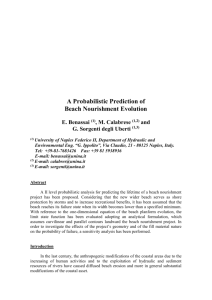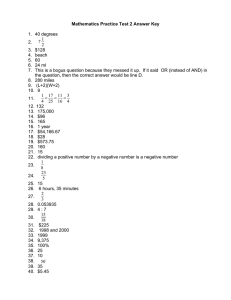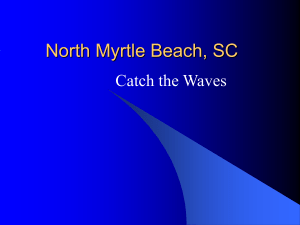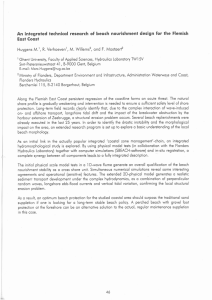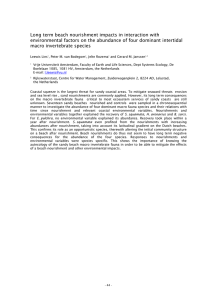MULTIVARIATE VISUALIZATION OF DATA QUALITY ELEMENTS FOR COASTAL ZONE MONITORING
advertisement
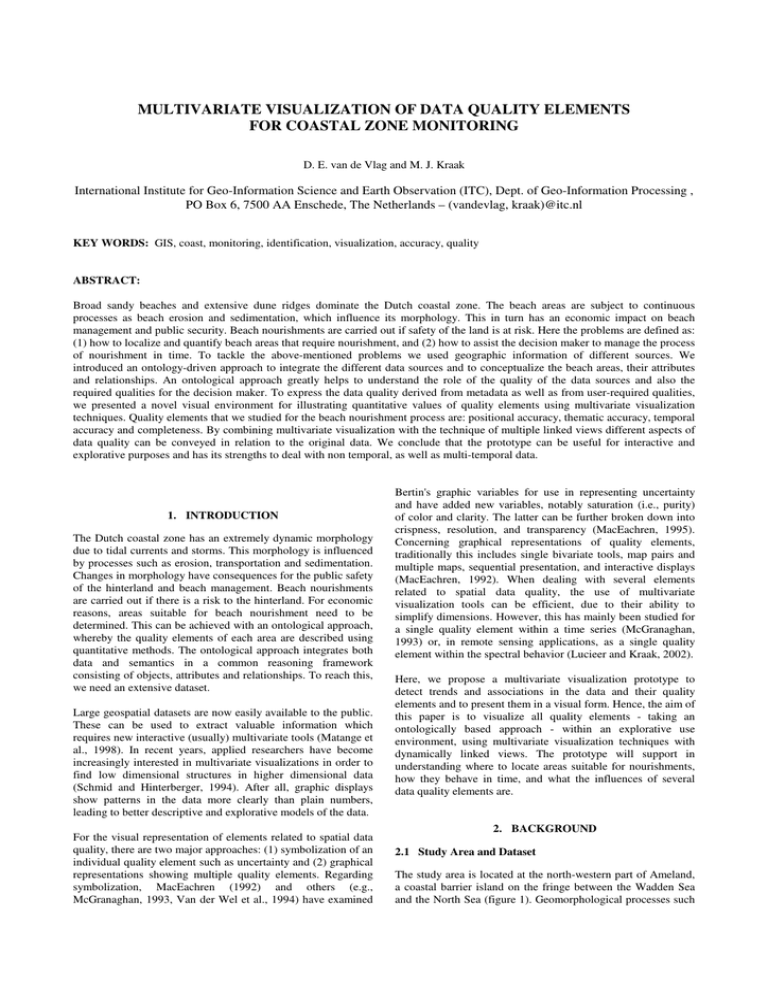
MULTIVARIATE VISUALIZATION OF DATA QUALITY ELEMENTS
FOR COASTAL ZONE MONITORING
D. E. van de Vlag and M. J. Kraak
International Institute for Geo-Information Science and Earth Observation (ITC), Dept. of Geo-Information Processing ,
PO Box 6, 7500 AA Enschede, The Netherlands – (vandevlag, kraak)@itc.nl
KEY WORDS: GIS, coast, monitoring, identification, visualization, accuracy, quality
ABSTRACT:
Broad sandy beaches and extensive dune ridges dominate the Dutch coastal zone. The beach areas are subject to continuous
processes as beach erosion and sedimentation, which influence its morphology. This in turn has an economic impact on beach
management and public security. Beach nourishments are carried out if safety of the land is at risk. Here the problems are defined as:
(1) how to localize and quantify beach areas that require nourishment, and (2) how to assist the decision maker to manage the process
of nourishment in time. To tackle the above-mentioned problems we used geographic information of different sources. We
introduced an ontology-driven approach to integrate the different data sources and to conceptualize the beach areas, their attributes
and relationships. An ontological approach greatly helps to understand the role of the quality of the data sources and also the
required qualities for the decision maker. To express the data quality derived from metadata as well as from user-required qualities,
we presented a novel visual environment for illustrating quantitative values of quality elements using multivariate visualization
techniques. Quality elements that we studied for the beach nourishment process are: positional accuracy, thematic accuracy, temporal
accuracy and completeness. By combining multivariate visualization with the technique of multiple linked views different aspects of
data quality can be conveyed in relation to the original data. We conclude that the prototype can be useful for interactive and
explorative purposes and has its strengths to deal with non temporal, as well as multi-temporal data.
1. INTRODUCTION
The Dutch coastal zone has an extremely dynamic morphology
due to tidal currents and storms. This morphology is influenced
by processes such as erosion, transportation and sedimentation.
Changes in morphology have consequences for the public safety
of the hinterland and beach management. Beach nourishments
are carried out if there is a risk to the hinterland. For economic
reasons, areas suitable for beach nourishment need to be
determined. This can be achieved with an ontological approach,
whereby the quality elements of each area are described using
quantitative methods. The ontological approach integrates both
data and semantics in a common reasoning framework
consisting of objects, attributes and relationships. To reach this,
we need an extensive dataset.
Large geospatial datasets are now easily available to the public.
These can be used to extract valuable information which
requires new interactive (usually) multivariate tools (Matange et
al., 1998). In recent years, applied researchers have become
increasingly interested in multivariate visualizations in order to
find low dimensional structures in higher dimensional data
(Schmid and Hinterberger, 1994). After all, graphic displays
show patterns in the data more clearly than plain numbers,
leading to better descriptive and explorative models of the data.
For the visual representation of elements related to spatial data
quality, there are two major approaches: (1) symbolization of an
individual quality element such as uncertainty and (2) graphical
representations showing multiple quality elements. Regarding
symbolization, MacEachren (1992) and others (e.g.,
McGranaghan, 1993, Van der Wel et al., 1994) have examined
Bertin's graphic variables for use in representing uncertainty
and have added new variables, notably saturation (i.e., purity)
of color and clarity. The latter can be further broken down into
crispness, resolution, and transparency (MacEachren, 1995).
Concerning graphical representations of quality elements,
traditionally this includes single bivariate tools, map pairs and
multiple maps, sequential presentation, and interactive displays
(MacEachren, 1992). When dealing with several elements
related to spatial data quality, the use of multivariate
visualization tools can be efficient, due to their ability to
simplify dimensions. However, this has mainly been studied for
a single quality element within a time series (McGranaghan,
1993) or, in remote sensing applications, as a single quality
element within the spectral behavior (Lucieer and Kraak, 2002).
Here, we propose a multivariate visualization prototype to
detect trends and associations in the data and their quality
elements and to present them in a visual form. Hence, the aim of
this paper is to visualize all quality elements - taking an
ontologically based approach - within an explorative use
environment, using multivariate visualization techniques with
dynamically linked views. The prototype will support in
understanding where to locate areas suitable for nourishments,
how they behave in time, and what the influences of several
data quality elements are.
2. BACKGROUND
2.1 Study Area and Dataset
The study area is located at the north-western part of Ameland,
a coastal barrier island on the fringe between the Wadden Sea
and the North Sea (figure 1). Geomorphological processes such
as erosion, transport and sedimentation of sandy materials are
causing major changes along the north-western coast of
Ameland.
In this study we focus on beach nourishments as their effects on
the maintenance of the coastline are better known.
According to Dutch policy regulations, beach nourishments are
carried out (1) if safety of the hinterland is at risk, (2) to
safeguard dune objects, (3) to stimulate and manage beach
recreation, or (4) to reduce the loss of nature areas (Roelse,
2002). To calculate the required volume of sand, the expected
erosion, the recurrence interval and the sand reserve have to be
determined. The sand reserve, i.e. the beach volume at time (t, is
the most important variable and can be calculated from the
dataset. Reference is made to the basal coastline, being the
coastline position on 1 January 1990. The beach volume at
basal coastline is the standard for preservation of the coastline.
Beach nourishments are carried out when the beach volume at
actual coastline is below the volume at basal coastline. The
actual beach volume can be calculated by multiplying the beach
area, i.e. the area between the dune feet and the actual coastline,
with the surface area.
For beach management purposes, Rijkwaterstaat - the part of the
Ministry of Public Works responsible for the maintenance of
the coast - divide the beach area into compartments. Each
compartment has two boundaries to its adjacent compartment
(CL), a beach-sea boundary (BS) and a beach-dune boundary
(BD). Rijskwaterstaat use these compartments to calculate sand
volumes and treat them as crisp objects (Roelse, 2002). The
interest of this application is to take into account the ‘fuzzy’
nature of objects, and their ‘dynamism’ in time. Hence, we
propose to describe the boundaries between beach-sea and
beach-dune as vague boundaries (Van de Vlag et al., 2004).
Figure 1: A landsat image (1999) from the north-western part of
the Isle of Ameland. The white box shows the study
area. The bottom part of the study area contains
mainly dunes, the middle part is beach, the upper part
is sea.
The dataset for the Ameland case study consists of multitemporal digital elevation models and satellite imagery. Each
digital elevation model of Ameland is derived from the
JARKUS data from the DONAR database (Eleveld, 1999). The
DONAR database contains annual beach and foredune profiles
derived from stereometric analysis of aerial photographs for the
dry part of the coastal transect. The underwater part of the
profile is measured with echosoundings from ships with
automatic position-finding systems. The transects are 200 to
250 m apart and elevation is measured at 5 m intervals along a
cross-shore line. From the point data, we interpolated the
profiles towards a 30 m × 30 m grid. Satellite images are
derived from Landsat5-TM and Landsat7-ETM+ satellites.
Landsat images contain pixels corresponding to 30 m × 30 m
ground surface.
Next, it is possible to calculate structural erosion per
compartment, by plotting the beach volumes from before 1990
against the beach volume with the basal coastline. A negative
trendline indicates erosion, whereas a positive trendline
indicates sedimentation.
Two constraints apply when deciding upon nourishment; first
constraint (C1) is that a coast compartment shows structural
erosion, the second constraint (C2) is that the volume for beach
nourishment should exceed 0.2 Mm3. Constraint C2 is a soft
constraint, as nourishment may be carried out, depending on
local and regional policies.
2.3 Ontological Approach
2.2 Beach Nourishment
The ontological approach chosen in this paper is to handle the
underlying data management problem as an integration of both
data and semantics, within a common reasoning framework
(Jeansoulin and Wilson, 2002). The ontological approach
clarifies the structure of knowledge, and leads to coherent
knowledge base. An ontology exists of objects, their attributes
and relationships (that may be time dependent), events,
processes and states. Ontologies may enable knowledge sharing
and reuse for different domains or time intervals. For the
Ameland application, ontologies will be used as a common
reasoning framework with different, yearly, time intervals. In
the Ameland case study, the spatio-temporal problem can be
defined as: 1) How to localize and quantify beach areas that
require nourishment, and 2) How to assist the decision maker to
manage the process of nourishment in time.
To counteract beach erosion, sand nourishments have to be
carried out. Either beach nourishments or underwater
nourishments are applied for sand nourishments (Roelse, 2002).
Identification of areas that require beach nourishment depends
upon terrain altitude (height around zero), vegetation index
(non-vegetated zones) and wetness index (dry zones). Altitudes
The beach objects are structured in compartments within a
higher conceptual level, based on perceivable regions on the
beach. Compartments are the regions between two transects.
between –1 and 2 m at Dutch standard sea-level (NAP) are
considered as beach areas. Such areas are derived from digital
elevation models (DEMs). Similarly, non-vegetated and dry
zones are derived from Landsat TM imagery. Non-vegetated
zones are selected as areas with negative NDVI values; dry
zones are selected as areas with a wetness index lower than
zero. The delimitation of the object beach should satisfy the
constraints for altitude, non-vegetated and dry zones (Vasseur
et. al., subm.).
The description of the spatio-temporal ontology depends on two
factors: the spatial variation of the attributes within a
compartment and its changes in time. The spatial variation is
inherited in several attributes, as altitude, vegetation index and
wetness index. In the definitions for beach nourishment, the
attributes are vaguely described in contents and geometry.
Beach compartments can be described by a membership of dry,
non-vegetated beaches (Van de Vlag et al., 2004). Additionally,
each attribute has a different timescale. Hence, different
temporal scale issues need to be incorporated. Beach volumes
derived from altitude can be described on yearly trends. The
vegetation index has monthly fluctuations, while wetness index
is characterized by tide fluctuations on a daily scale.
The spatial variation of the attributes can be modeled using
fuzzy logic, whereby beach compartments suitable for beach
nourishment are determined by its membership to dry, nonvegetated beaches. Hence, a compartment is bound by two static
compartment boundaries (CL.geo) and by two vague
boundaries: the sea-beach boundary (BS.geo(t)) and the beachdune boundary (BD.geo(t)).These boundaries are illustrated in
figure 2, lower image.
Figure 2: Compartment, boundaries and their various fuzzy membership functions. The lower image visualizes a compartment (C),
with two adjacent crisp boundaries (CL) and two fuzzy boundaries (BS) and (BD).
The sand volume within the fuzzy compartmental method can
be calculated, using:
C.vol(t) = ps ×
np
m(i, t) × e(i, t)
(1)
i =1
where m(i,t), membership value of location (i) in compartment
C at time t. It is calculated as:
m(i, t ) = min{mb(i, t ), md (i, t ), mv(i, t )}
(2)
where mb(i,t) is the membership function of the beach object,
md(i,t) that of dry object and mv(i,t) that of a non-vegetated
object in which pixel i occurs at time t (see figure 2).
Membership functions are compiled as triangular functions and
are semantic based. The mb(i,t) equals 1 if altitude ranges from
0 to 1 m amsl (i.e. above mean sea level). It increases linearly
from 0 to 1 between –1.1 to 0 m amsl and decrease linearly
from 1 to 0 between 1 and 3 m amsl, and it equals 0 elsewhere.
The md(i,t) equals 1 if wetness index is less than -3, and
decrease linearly from 1 to 0 for the wetness index moving from
-3 to 3 m amsl, and it equals 0 elsewhere. Finally, the mv(i,t)
equals 1 if the ndvi value is less than -0.05, it equals 0 if the
ndvi is larger than 0.05 and it decrease linearly from 1 to 0 in
between.
To include temporal uncertainty into the beach nourishment
processes, we consider daily fluctuations for the wetness index,
monthly fluctuations for the vegetation index and yearly
fluctuations for altitude. These assumptions are based on
observation methods and applied on the most appropriate time
scale for these attributes. However, weather influences are
neglected as these are complicated to observe and difficult to
model due to several time dimensions.
Temporal membership functions are introduced, which have the
highest values when the most reliable data can be collected. For
vegetation, the nv(t) equals 1 between 1 June and 1 August, it
equals 0.5 between 1 November until 1 March, and it is linear
in between. Similarly nd(t) equals 1 during flood time and
equals 0.5 during low tide, and further follows a sine form, i.e.
nd(t) = 0.75+0.25·cos(2π·t/12.5), with t expressed in hours in
relation to high tide. Finally, the function nb(t) is included to
describe the actual digital elevation model. For the simplicity,
we correct the slopes of the membership functions derived from
equations (1) and (2) with a correction factor related to the
temporal (un)certainty of the vegetation- and wetness index, as
described above.
2.4 Quality Elements and Quality Matrix
2.4.1. Quality elements: For the spatial uncertainty of the
beach compartments, we encounter the following ISO quality
elements and subelements as most essential (ISO 2003):
o Positional accuracy
Relative or internal: closeness of the relative positions
of objects in a dataset to their respective relative
positions accepted as or being true.
Gridded data position: closeness of gridded data
position values to values accepted as or being true.
o Thematic accuracy
Accuracy of quantitative attributes: the correctness of
quantitative attributes and of the classifications of
objects and their relationships.
Classification correctness: comparison of the classes
assigned to objects or their attributes to a universe of
discourse (e.g. ground truth or reference dataset).
o Completeness
Data completeness: the commission and omission of
datasets.
For the temporal uncertainty of the compartments, we recognize
for different time scales:
o Temporal accuracy
Accuracy of a time measurement: correctness of the
temporal references of an item (reporting of error in
time measurement).
2.4.2. Quality matrix: By applying an ontological approach,
we can construct a quality matrix, whereby ontological features
as objects, attributes relationships, processes and events are
projected against quality elements, as described above. Table 1
describes the quality of objects, attributes and processes in a
general fashion that applies to the case study. Different
membership functions occur, whereas spatial and temporal
accuracy apply to a limited set of objects.
The prominent feature of interest is the amount of beach
volume, represented by C.vol in table 1. Within one year, C.vol
can be calculated for each compartment, as well as its quality
parameters (see table 2).
3. VISUALIZATION OF THE QUALITY MATRIX
In the beach nourishment application, we can easily depict a
map with beach compartments suitable for nourishment.
However, trends and associations between compartments,
changes in time and quality elements involved in the decision
making, are more complicated to visualize. As quality elements
are multivariate in purpose – i.e. there are many quality
elements studied for each ontological feature – multivariate
visualization tools are the most appropriate display technique.
Furthermore, to detect trends and the evolution of the quality
elements in time, a temporal element should be included in the
visualization tool.
Objects
C.id
CL.id
BD.id
BS.id
Attributes
C.vol
C.vol90
CL.geo
BD.geo
BD.ndvi
BD.z
BS.geo
BS.wi
BS.z
C.se
Processes
C.vol/t
TL.id
TL.trend
Positional
Thematic
Accuracy
Accuracy
Rel.
Grid. CC
QAA
48.6 m 30.3 m
NR
30.3 m
48.6 m 30.3 m
48.6 m 30.3 m
48.6 m
48.6 m
NR
48.6 m
48.6 m
NR
48.6 m
48.6 m
NR
48.6 m
30.3 m mv(i,t)
30.3 m mv(i,t)
30.3 m
30.3 m mv(i,t)
30.3 m
30.3 m
30.3 m mv(i,t)
30.3 m
30.3 m
30.3 m mv(i,t)
Compl.
Data
86.7%
86.7%
86.7%
86.7%
± 0.28 m 86.7%
NR
86.7%
86.7%
NR
86.7%
± 0.28 m 86.7%
86.7%
NR
86.7%
± 0.28 m 86.7%
86.7%
Temp.
Acc.
ATM
< 1 year
< 1 year
< 1 year
< 1 year
nb(t)
nb(t)
nv(t)
nd(t)
nd(t)
< 10 year
< 1 year
< 1 year
Table 1. Quality elements for the ontological features for 1995.
Abbreviations: CC = classification correctness, QAA
= quantitative attribute accuracy, ATM = accuracy of
time measurement, NR = not relevant.
C.id C.vol
#
260
280
300
301
302
303
304
320
m3
1.02E+04
6.87E+03
2.01E+03
4.82E+02
2.56E+03
3.18E+03
5.33E+03
…
Positional
Accuracy
Thematic
Accuracy
Compl.
Temp.
Acc.
Rel.
Grid. CC
QAA Data
ATM
m
48.6
48.6
48.6
48.6
48.6
48.6
48.6
…
m
30.3
30.3
30.3
30.3
30.3
30.3
30.3
…
m
0.28
0.28
0.28
0.28
0.28
0.28
0.28
…
%
0.326
0.331
0.275
0.255
0.324
0.313
0.290
…
%
0.212
0.185
0.169
0.123
0.253
0.167
0.198
…
%
0.133
0.133
0.133
0.133
0.133
0.133
0.133
…
Table 2. Amount of beach volume for each compartment (C.vol)
and its quality elements for 1995. Abbreviations: C.id
= compartment id., C.vol = beach volume per
compartment, CC = classification correctness, QAA =
quantitative attribute accuracy, ATM = accuracy of
time measurement, NR = not relevant.
Here, we discuss some aspects to fulfil the aim to construct a
prototype illustrating the quality elements involved in a beach
nourishment process. First, it should incorporate interactivity
between separate windows, i.e. it should have dynamically
linked views. Second, the prototype should handle high
dimensionality of the attributes, using multivariate visualization
tools. Last, it should be able to deal with multi temporal
datasets and to detect trends in the beach nourishment process
and its quality elements during multiple time observations.
3.1 Dynamically Linked Views
With dynamically linked views we mean that graphs (e.g.
multivariate visualization techniques) and maps are displayed
separately but dynamically linked. If one element in a map is
clicked, the corresponding elements in other maps or graphs
will be highlighted. Conversely, by clicking on these
information elements in a graph, the particular object will be
highlighted in the map. Dynamically linked views increase the
user interactivity and are now considered indispensable for
supporting data exploration.
In the beach nourishment application, these information
elements concern the quality elements from table 2, which can
be activated by pressing the mouse button at a compartment. A
separate graphic will show the quality values for that particular
compartment. Also, by clicking on a phenomenon in a graphic,
the compartment concerned will be highlighted in the map.
3.2 Multivariate Visualization Tools
There are several methods to visualize spatial data quality
(McGranaghan, 1993; Lucieer and Kraak, 2002; Van der Wel et
al., 1994). Here, we focus on multivariate visualization
techniques for illustrating the quality elements for beach
nourishments derived from the ontological approach.
Over the past decade, many different visualization techniques
have been developed (Card et al., 1999). For geographic data,
visualization techniques can be categorized in geometrically
transformed displays or iconic displays. The geometrically
transformed displays include the scatterplot matrix, a commonly
used method in statistics, and the parallel coordinate plot
(Inselberg, 1985), that is a popular technique in exploratory
visualization. Star plots (Chambers et al., 1983) and Chernoff
faces (Chernoff, 1973) are techniques of iconic displays that
visualize each data item as an icon and the multiple variables as
features of the icons. From all these techniques, the dynamic
parallel coordinate plot has been demonstrated as a powerful
multivariate visualization technique (Spence, 2001) and has
been used in several applications (McGranaghan, 1993; Lucieer
and Kraak, 2002).
The dynamic parallel coordinate plot was introduced in 1985 by
Inselberg (Inselberg, 1985). The display is obtained by taking
dimensions as vertical axes thereby arranging them parallel to
each other. The individual data values are then marked off for
each dimension onto corresponding coordinate with the highest
data value as maximum value and the lowest as minimum. From
the structure of the resulting display one can draw conclusions
for the relationship of the corresponding data values. A group of
lines with a similar gradient can, for example, indicate that their
data records correlate positively. Furthermore, outliers in values
are easy to detect.
3.3 Temporal Ordered Space Matrix
To deal with multi-temporal datasets, we propose a novel
visualization technique, whereby linear elements (as with
coastline compartment) are portrayed against the temporal
variations of a particular user-defined quality element.
Therefore, we construct a matrix of squares, named temporal
ordered space matrix. In horizontal direction, the matrix is a sort
of schematized map and represents each compartment as a cell
in identical order as in Cartesian space. Hence, compartments
in the west of the study area are depicted in the matrix left of
compartments in the east. The decision maker needs to reflect
each quality element with a conformance quality level, i.e. a
threshold value. When quality elements fulfil the threshold
value, they are shown as green cells. However, if they fail, they
are show as red cells. Quality elements close to the threshold
value are shown as orange cells. The time is projected in
vertical direction. Hence, the evolution of quality elements can
be easily interpreted from the temporal ordered space matrix.
The main advantage of using ordered space is the preservation
of the adjacency relations between the compartments. This will
assist the decision maker in understanding and detecting areas
where effects of quality elements are important.
4. PROTOTYPE
Using the results of table 2 and visualization techniques as
mentioned above, we designed a prototype for multivariate
visualization, composed of three sections (see figure 3). The
first section is the main interface that displays a base map of the
study area. A pull-down menu gives the user the selection of
maps illustrating the beach volume or particular quality
elements for each compartment.
The second section consists of a parallel coordinate plot (PCP).
In the PCP each line represents a compartment. The vertical
axis shows the quality elements derived from table 2 for each
compartment. Here, the lower a line is located in the plot, the
better the dataset meets the user’s preferences. In the PCP the
user can also the possibility to display the available datasets for
all times. Consequently, the PCP will display a particular
quality element as a time series, with the recorded date on the
vertical axis. A menu next to the display will give the
opportunity to display the quality elements per compartment or
as a timeserie.
The third section is the temporal ordered space matrix. Next to
the matrix is an entry menu, where the user can select a
particular quality element. Additionally, the user can enter a
threshold value for a particular quality element. The distribution
of this quality element in (ordered) space and time, as well as its
ability to meet the threshold value, will be depicted in this
matrix.
The prototype enables interactivity between the sections. The
user can explore the dynamically linked displays by pointing the
mouse on a compartment in the map and the corresponding
PCP-axis or matrix cell becomes highlighted. Vice versa, the
user can point on specific line or matrix cell leading to the
highlighted contour of the corresponding compartment. Even
more, the user can select a dataset by a moving window in the
temporal ordered space matrix. Besides, the user can select a
threshold value, changing the color legend of the map and the
PCP (see figure 3).
5. DISCUSSION
The prototype for multivariate visualization of spatial data
quality elements can be useful for interactive and explorative
purposes. Further elaboration of the prototype will help in
understanding datasets and their quality elements by instant
view. Its effectiveness towards insight of the data and their
shortcomings related to their quality, help decision makers to
determine which objects are of interest for beach nourishments.
For general purposes, a multivariate visualization tool as
proposed by this prototype is useful for decision makers to
understand the dataset and to support the decision makers in
their analyses or predictions.
Figure 3: A prototype for multivariate visualization of quality elements for the beach nourishment process. Section 1 is the main
display, showing the thematic uncertainty of the compartments for 1995. Section 2 is parallel coordinate plot, showing all
quality elements for every compartment. In the PCP menu the user can select to visualize all quality elements per
compartment or as a timeserie. Section 3 is the temporal ordered space matrix. In the TOSM menu, the user can enter a
threshold value for an user-required quality. With a window slider the user can select a specific observed dataset.
For proper use of the visualization tool, it is essential that a user
understands the objectives of the visual exploration and the
meaning of what is visible in the patterns displayed. The
visualization tool must be straightforward and uncomplicated in
order to support rather than obstruct understanding. Therefore, a
working prototype needs to be developed and introduced to
several users for empirical assessment and comments. Users’
comments will be vital to determine whether the techniques are
comprehensible, and also to determine the degree to which
users may be able to benefit from visualization of quality
elements. These comments are needed in order to refine design
requirements for a prototype visualization environment.
Hence, the usability of the prototype will be tested by a group of
target users. The users have a chance to try out the working of
the prototype. Furthermore, the users’ performance with the
prototype will be measured against predefined quantitative and
qualitative usability specifications. Subsequently, the outcome
of the usability test will show whether the product is a success
or not. Faulkner (2000) states that usability information
gathered from this final stage of a usability evaluation process is
important for future projects, although the shortcomings are,
that the test only last for limited time periods and the method
emphasize first time usage.
When visualizing multi-temporal data, it seems obvious to use
animation techniques. Animation produces strong visual effect
on the viewer and it is able to demonstrate some rather apparent
trends, like beach erosion or sedimentation. On the other hand,
the usefulness of animation for data exploration, i.e. for the
detection of new knowledge, must not be overestimated
(Adrienko et al., 2000). It is hard to differentiate between
images when we compare states of a phenomenon at different
time moments or when changes over time are minimal or
scattered. Recently a number of tools for controlling animation
have been suggested that improve its suitability for analysis
(Kraak, 2003). Further advancement of the map animation
technique can be achieved by means of combining it with
additional displays of the same data as well as various
transformations of the data. In particular, the amount of change
between two time moments can be computed and visualized.
For visualizing multivariate multi-temporal datasets, animation
tools might not be the most appropriate visualization technique.
Therefore, we chose to show individual quality elements for
each compartment in a temporal ordered space matrix.
6. CONCLUSION
We designed a prototype for multivariate visualization, to detect
trends and associations in the data and represent its quality
elements. As a case study, we apply an ontologically based
approach on a beach management application, to derive to
quality elements involved for beach nourishment. By means of
multivariate visualization of quality elements, the prototype will
help in understanding datasets and their quality elements by
instant view. Its effectiveness towards insight of the data and
their shortcomings related to their quality, help decision makers
to determine which objects are of interest for beach
nourishments. The prototype can be useful for interactive and
explorative purposes and its strength to deal with non temporal,
as well as multi-temporal data.
ACKNOWLEDGEMENTS
The work was funded by the European Community, under IST1999-14189 project REV!GIS. The datasets have been made
available by Rijkswaterstaat and RIKZ.
REFERENCES
Andrienko, N., Andrienko, G., and Gatalsky, P. (2000) Towards
Exploratory Visualization of Spatio-Temporal Data. 3rd AGILE
Conference
on
Geographic
Information
Science,
Helsinki/Espoo, May 25-27, pp.137-142
Card, S.K., Mackinlay, J.D., Shneiderman, B. (Eds.) (1999)
Readings in Information Visualization. Using Vision to Think.
Morgan Kaufmann Publishers, Inc, San Francisco.
Chambers, J.M., Cleveland, W.S., Kleiner, B., & Tukey, P.A.
(1983). Graphical Methods for Data Analysis. Belmont, CA:
Wadsworth.
Chernoff, H. (1973). The use of faces to represent points in kdimensional space graphically. Journal of the American
Statistical Association, 68:361-368.
Faulkner, X. (2000). Usability Engineering. Palgrave, New
York.
Inselberg, A. (1985). The plane with parallel coordinates. The
Visual Computer 1(2): 69-91.
ISO (2003). "ISO/TC 211 Geographic information/Geomatics 19113, 1914, Geographic information quality, and evaluation
procedures, as sent to the ISO Central Secretariat for
publication." 68 p.
Jeansoulin, R. and Wilson, N., (2002). Quality of Geographic
Information: Ontological approach and Artificial Intelligence
Tools in the REV!GIS project, 8th EC-GI&GIS Workshop,
Dublin 3-5 July, 2002.
Kraak, M.J. (2003). Geovisualization illustrated. ISPRS Journal
of Photogrammetry and Remote Sensing, 57 (1) pp. 1-10.
Lucieer, A. and Kraak, M. (2002). Interactive visualization of a
fuzzy classification of remotely sensed imagery using
dynamically linked views to explore uncertainty. In Hunter, G.
and Lowell, K., editors, Proceedings Accuracy 2002, 5th
International Symposium On Spatial Accuracy Assessment in
Natural Resources and Environmental Sciences, pages 348-356,
Melbourne, Australia.
MacEachren, A.M., (1992). Visualizing uncertain information.
Cartographic Perspectives, no. 13, p. 10-19.
MacEachren, A.M. (1995). How maps work, representation,
visualization, and design. New York etc.: The Guiford Press.
McGranaghan, M. (1993). A Cartographic View of Spatial Data
Quality, Cartographica, 30(2 & 3), pp. 8-19.
Matange, S, Beamon, J. and Huffman, C. (1998).
Multidimensional Data Visualization Tools. SAS Institute Inc.,
Cary. NC. Proceedings of the Twenty-Third Annual SAS users
group international, Nashville, Tennessee. 22-25 March 1998.
http://www2.sas.com/proceedings/sugi23/Infovis/p145.pdf
Roelse, P., (2002). Water en Zand in Balans. Evaluatie
zandsuppleties na 1990; een morfologische beschouwing.
Internal Report Rijksinsituut voor Kust en Zee, 2002.003,
Middelburg, The Netherlands, 108 pp.
Schmid, C. and Hinterberger H. (1994). Comparative
Multivariate Visualization Across Conceptually Different
Graphic Displays. Proceedings of the Seventh International
Working Conference on Statistical and Scientific Database
Management, SSDBM 94, Charlottesville, Virginia, September
28 - 30, 1994, IEEE Computer Society Press, Los Alamitos,
California, 1994.
Spence, R. (2001). Information Visualization, Addison Wesley /
ACM Press Books, Harlow.
Van der Wel, F.J.M., Hootsman, R.M., and Ormeling, F.J.
(1994). Visualization of data quality, in MacEachren, A.M., and
Taylor, D. R. F., eds., Visualization in Modern Cartography,
Elsevier, Amsterdam, p. 67-92.
Van de Vlag, D.E., Stein A. and Vasseur, B. (2004). Concepts
and Representation of Beach Nourishments by Spatio-temporal
Ontologies. In Proceedings of the ISSDQ ’04, GeoInfo Series,
Vienna. pp. 353-369
Vasseur, B., Vlag, D.E. van de, Stein, A, Jeansoulin, R. and
Dilo, A. (subm.), Ontologie Spatio-Temporelle d’Objets Flous
et Dynamiques pour la Maintenance des Zones Côtières
Hollande. In: Revue Internationale de Géomatique, Numéro
Spécial ‘les Ontologies Spatiales’.


